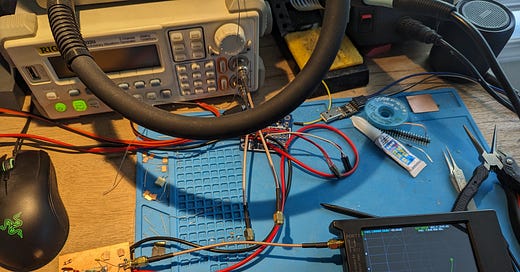Happy Father’s Day to all of the dads out there!
I just had my last day of work at my previous job and I’m now solely dependent on my new WFH job, so hopefully I’ll have a little more time to put into Etherkit and Project Yamhill. Here’s a paid subscriber post about a small side project that will feed into Project Yamhill and other radios for Etherkit. The next post will be for all subscribers and will give the next updates on Project Yamhill. Thanks again to all of those who have a paid subscription! I may have a post riffing on the economics of doing these small hobby businesses soon too, so beware…
I’m sure that just about every reader of this publication who has done their own QRP transceiver kit building or homebrewing is familiar with the venerable NE602/SA612 Gilbert cell mixer IC. It’s been used in a very large number of these radios, because of its excellent level of integration of many RF mixer and oscillator components, low current draw, relative low cost, good gain, and ease of use. The IP3 characteristics aren’t that great, but trading that aspect off for all of the previously mentioned positive traits has been an easy decision to make for a lot of QRP radio designs.
The problem in 2024 is that this part was recently EOLed, and you can no longer obtain them from the usual reputable parts dealers. You do see some currently-selling radios using them, but I suspect that the manufacturers of these rigs either already have a large supply of the part on hand, or have a secondary market supplier for them that they trust. Even if that’s the case, the remaining supply won’t last forever, so it would be wise to look for a replacement that can function similarly to the SA612.
I’ve been keeping my eyes open for a bit, and while looking at parametric tables of mixer ICs, I never did see anything that looked like it was close to a drop-in replacement for the SA612. I did keep coming back to a particular family of active mixer ICs, the Maxim MAX2680/MAX2681/MAX2682, that seemed to have similar characteristics (specifically gain, current draw, and IIP3) to the SA612, so might be a viable candidate. It doesn’t have the provision for its own internal oscillator, which isn’t a deal-breaker. But the specifications listed the IC as for use as a downconverting mixer at RF frequencies from 400 MHz to 2.5 GHz, and IF frequencies of 10 MHz to 500 MHz. However, just because the manufacturer only guarantees the mixer to work as specified at the listed frequencies doesn’t mean that it couldn’t still be useful at HF frequencies. It seemed wise to do some tests to see whether it would work at all at HF, and what kind of performance you could get. So when I placed my last components order, I included a few MAX2681 ICs in the order to use for eventual testing.
Because I’m getting a large PCB order ready to send out for manufacturing, I figured that now was a good time to design a quick PCB for using the MAX268x with Project Yamhill, in order to take advantage of paying for the already large amount of shipping costs I was already going to eat. But before laying out that PCB, I needed to check to see whether the IC was even viable for use at HF, which brings us to the substance of today’s post.
Keep reading with a 7-day free trial
Subscribe to Applied Etherics to keep reading this post and get 7 days of free access to the full post archives.




